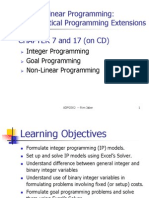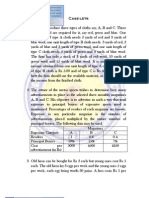UECM2043, UECM2093 Operations Research Tutorial 2
UECM2043, UECM2093 Operations Research Tutorial 2
Uploaded by
kamun0Copyright:
Available Formats
UECM2043, UECM2093 Operations Research Tutorial 2
UECM2043, UECM2093 Operations Research Tutorial 2
Uploaded by
kamun0Original Description:
Original Title
Copyright
Available Formats
Share this document
Did you find this document useful?
Is this content inappropriate?
Copyright:
Available Formats
UECM2043, UECM2093 Operations Research Tutorial 2
UECM2043, UECM2093 Operations Research Tutorial 2
Uploaded by
kamun0Copyright:
Available Formats
1
UECM2043, UECM2093 Operations Research
Tutorial 2
1. Consider the following LP:
Maximize = 2
1
+3
2
subject to
1
+3
2
6
3
1
+2
2
6
1
,
2
0
a) Express the problem in equation form.
b) Determine all the basic solutions of the problem, and classify them as feasible and
infeasible.
c) Use direct substitution in the objective function to determine the optimum basic
feasible solution.
d) Verify graphically that the solution obtained in (c) is the optimum LP solution. Hence,
conclude that the optimum solution can be determined algebraically by considering
the basic feasible solutions only.
e) Show how the infeasible basic solutions are represented on the graphical solution
space
2. Consider the following LP with two variables:
Max = 8
1
+ 4
2
Subject to
2
1
+
2
4
1
+2
2
5
1
,
2
0
Consider the graphical solution of the problem. Identify the path of the simplex method
and the basic and nonbasic variables that define this path.
3. Consider the following set of constraints:
1
+2
2
+ 2
3
+ 4
4
40
2
1
2
+
3
+ 2
4
8
4
1
2
2
+
3
4
10
1
,
2
,
3
,
4
0
Solve the problem for each of the following objective functions.
(a) Maximize = 2
1
+
2
3
3
+5
4
.
(b) Minimize = 5
1
4
2
+6
3
8
4
.
4. The following tableau represents a specific simplex iteration. All variables are
nonnegative. The tableau is not optimal for either a maximization or a minimization
problem. Thus, when a nonbasic variable enters the solution it can either increase or
2
decrease z or leave it unchanged, depending on the parameters of the entering nonbasic
variable.
Basic x
1
x
2
x
3
x
4
x
5
x
6
x
7
x
8
Solution
z 0 -5 0 4 -1 -10 0 0 620
x
8
0 3 0 -2 -3 -1 5 1 12
x
3
0 1 1 3 1 0 3 0 6
x
1
1 -1 0 0 6 -4 0 0 0
a) Categorize the variables as basic and nonbasic and provide the current values of all
the variables.
b) Assuming that the problem is of the maximization type, identify the nonbasic
variables that have the potential to improve the value of z. If each such variable enters
the basic solution, determine the associated leaving variable, if any, and the associated
change in z. Do not use the Gauss-J ordan row operations.
c) Repeat part (b) assuming that the problem is of the minimization type.
d) Which nonbasic variable(s) will not cause a change in the value of Z when selected to
enter the solution?
5. The Gutchi Company manufactures purses, shaving bags, and backpacks. The
construction includes leather and synthetics, leather being the scarce raw material. The
production process requires two types of skilled labor: sewing and finishing. The
following table gives the availability of the resources, their usage by the three products,
and the profits per unit.
Resource requirement per unit
Resource Purse Bag Backpack Daily availability
Leather (ft
2
) 2 1 3 42 ft
2
Sewing (hr) 2 1 2 40 hr
Finishing (hr) 1 0.5 1 45 hr
Selling price ($) 24 22 45
Formulate the problem as a linear program and find the optimum solution by using the
simplex method.
6. Use the Big M method to solve the following LP:
Maximize = 2
1
+ 3
2
5
3
Subject to
1
+
2
+
3
= 7
2
1
5
2
+
3
10
1
,
2
,
3
0
3
7. Use the Big M method to solve the following LP:
Minimize = 4
1
8
2
+ 3
3
Subject to
1
+
2
+
3
= 7
2
1
5
2
+
3
10
1
,
2
,
3
0
8. Consider the following LP:
Maximize = 3
1
+2
2
subject to
4
1
2
4
4
1
+ 3
2
6
4
1
+
2
4
1
,
2
0
(a) Show that the associated simplex iterations are temporarily degenerate.
(b) Verify the result by solving the problem graphically.
9. For the following LP, identify three alternative optimal basic solutions, and then write a
general expression for all the nonbasic alternative optima comprising these three basic
solutions.
Maximize =
1
+2
2
+3
3
subject to
1
+ 2
2
+3
3
10
1
+
2
5
1
1
1
,
2
,
3
0
10. Consider the LP:
Maximize = 20
1
+10
2
+
3
subject to
3
1
3
2
+5
3
50
1
+
3
10
1
2
+ 4
3
20
1
,
2
,
3
0
(a) By inspecting the constraints, determine the direction (
1
,
2
,
3
) in which the
solution space is unbounded.
(b) Without further computations, what can you conclude regarding the optimum
objective value?
4
11. Consider the LP model
Maximize = 3
1
+2
2
+3
3
subject to
2
1
+
2
+
3
2
3
1
+4
3
+2
3
8
1
,
2
,
3
0
Show that the optimal solution includes an artificial basic variable at zero level. Does the
problem have a feasible optimal solution?
12. The NW Shopping Mall conducts special events to attract potential patrons. Among the
events that seem to aUract teenagers, the young/middle-aged group, and senior citizens,
the two most popular are band concerts and art shows. Their costs per presentation are
$1500 and $3000, respectively. The total (strict) annual budget allocated to the two events
is $15,000. The mall manager estimates the attendance as follows:
Number attending per presentation
Event Teenagers Young/middle age Seniors
Band concert 200 100 0
Art show 0 400 250
The manager has set minimum goals of 1000, 1200, and 800 for the attendance of
teenagers, the young/middle-aged group, and seniors, respectively. Formulate the
problem as a goal programming model. Suppose that the goal of attracting
young/middle-aged people is twice as important as for either of the other two categories
(teens and seniors). Find the associated solution, and check if all the goals have been
met.
13. Camyo Manufacturing produces four parts that require the use of a lathe and a drill press.
The two machines operate 10 hours a day. The following table provides the time in
minutes required by each part:
Production time in min
Part Lathe Drill press
1 5 3
2 6 2
3 4 6
4 7 4
It is desired to balance the two machines by limiting the difference between their total
operation times to at most 30 minutes. The market demand for each part is at least 10
units. Additionally, the number of units of part 1 may not exceed that of part 2.
Formulate the problem as a goal programming model.
Suppose that the market demand goal is twice as important as that of balancing the two
machines, and that no overtime is allowed. Solve the problem, and determine if the goals
are met.
You might also like
- Soal Latihan Excel Solver Dan LindoDocument3 pagesSoal Latihan Excel Solver Dan LindoSuryaAdhiSaputra100% (1)
- Operation Research HWDocument5 pagesOperation Research HWMuhammad Raditya RahagiNo ratings yet
- OR Assignments 29072018 054510PMDocument26 pagesOR Assignments 29072018 054510PMReema Catherine MathewNo ratings yet
- DM WK 1Document13 pagesDM WK 1Gaston Dereck AlexNo ratings yet
- Solution Manual For Modern Business Statistics 5th Edition by AndersonDocument8 pagesSolution Manual For Modern Business Statistics 5th Edition by Andersona222170614No ratings yet
- LP Graphical SolutionDocument23 pagesLP Graphical SolutionSachin YadavNo ratings yet
- IPandBIPDocument30 pagesIPandBIPMritunjay HansdaNo ratings yet
- 2 Linear Programming ProblemDocument35 pages2 Linear Programming Problemangel190693100% (1)
- SampleFINAL KEY 205 TaylorDocument9 pagesSampleFINAL KEY 205 Tayloraskar_cbaNo ratings yet
- hw9 Process Control Solutions 2015 PDFDocument8 pageshw9 Process Control Solutions 2015 PDFWinpee SacilNo ratings yet
- Problem 3Document4 pagesProblem 3Julrick Cubio Egbus0% (1)
- MSS - CHP 3 - Linear Programming Modeling Computer Solution and Sensitivity Analysis PDFDocument10 pagesMSS - CHP 3 - Linear Programming Modeling Computer Solution and Sensitivity Analysis PDFNadiya F. ZulfanaNo ratings yet
- Linear Programming - The Graphical MethodDocument6 pagesLinear Programming - The Graphical MethodRenato B. AguilarNo ratings yet
- Lecture-The Simplex Method PDFDocument27 pagesLecture-The Simplex Method PDFMuhammad Kamran100% (1)
- Linear ProgrammingDocument15 pagesLinear Programmingjogindra singh100% (1)
- Assignment PDFDocument4 pagesAssignment PDFDark LightNo ratings yet
- 2b.modeling Linear and Integer ProgramsDocument42 pages2b.modeling Linear and Integer ProgramsEsra TanyıldızNo ratings yet
- PDF QT Practice SetDocument13 pagesPDF QT Practice Setpankaj5470100% (1)
- Goal Programming Goal Programming: DR Muhammad Al Salamah, Industrial Engineering, KFUPMDocument33 pagesGoal Programming Goal Programming: DR Muhammad Al Salamah, Industrial Engineering, KFUPMSusi UmifarahNo ratings yet
- AnswerDocument1 pageAnswerTI Logic ?? sobayedNo ratings yet
- Practice Problem: Chapter 3, Project ManagementDocument5 pagesPractice Problem: Chapter 3, Project ManagementWilfred AlvarezNo ratings yet
- (Quantitative Analysis) Linear ProgrammingDocument2 pages(Quantitative Analysis) Linear ProgrammingKiran BasuNo ratings yet
- Question Paper1Document6 pagesQuestion Paper1kshitij walkeNo ratings yet
- Optimization Problems 1Document12 pagesOptimization Problems 1AnjanNo ratings yet
- Tut3 STA4002Document5 pagesTut3 STA4002MinNo ratings yet
- Individual Assignment 3: Chapter 7: Process StrategyDocument2 pagesIndividual Assignment 3: Chapter 7: Process StrategyVũ Hoàng DiệuNo ratings yet
- Solving Linear ProblemasDocument27 pagesSolving Linear ProblemasLinita MariaNo ratings yet
- Operation Research Exercise PDFDocument9 pagesOperation Research Exercise PDFSerkalem AsfawNo ratings yet
- Integer Linear Programming: Multiple ChoiceDocument12 pagesInteger Linear Programming: Multiple ChoiceMarwa HassanNo ratings yet
- 2021 10 21 Session1Document67 pages2021 10 21 Session1Prateek BabbewalaNo ratings yet
- File: Winston Operations Research Solutions ManualDocument1 pageFile: Winston Operations Research Solutions Manualmuhammad fajryNo ratings yet
- Network Model Aplikasi QM For WindowsDocument5 pagesNetwork Model Aplikasi QM For WindowsJoven CastilloNo ratings yet
- Stevie Gibernau - Review Jurnal InternasionalDocument16 pagesStevie Gibernau - Review Jurnal InternasionalStevie Gibernau100% (1)
- Transportation Problem ExcelDocument4 pagesTransportation Problem Excelsachin_chawlaNo ratings yet
- Simulation Examples in A Spreadsheet: Book: Jerry Bank's Chapter 2Document39 pagesSimulation Examples in A Spreadsheet: Book: Jerry Bank's Chapter 2Xuân TrườngNo ratings yet
- Chapter 11 - Quiz (S.GN 2223)Document14 pagesChapter 11 - Quiz (S.GN 2223)Anastasia Putri SitumorangNo ratings yet
- Bank SoalDocument6 pagesBank SoalSusan RenaNo ratings yet
- UECM2043, UECM2093 Operations Research Tutorial 1Document5 pagesUECM2043, UECM2093 Operations Research Tutorial 1kamun00% (2)
- Bank Soal ErpDocument8 pagesBank Soal ErpREG.B/0219104008/JANA MULDANINo ratings yet
- Linear ProgrammingDocument62 pagesLinear ProgrammingPayal ChauhanNo ratings yet
- Tugas RO Integer Programming FormulationDocument3 pagesTugas RO Integer Programming FormulationRizky Indah Melly Eka100% (2)
- Operations ResearchDocument1 pageOperations ResearchKushal Bothra0% (1)
- Chapter 7: Project Time-Cost Trade-OffDocument14 pagesChapter 7: Project Time-Cost Trade-OffRefisa JiruNo ratings yet
- Tutorial 5 Discrete DistributionsDocument6 pagesTutorial 5 Discrete DistributionsRania GoujaNo ratings yet
- MC0079 - Computer Based Optimization MethodsDocument10 pagesMC0079 - Computer Based Optimization MethodsHarvinder SinghNo ratings yet
- Chapter 2 Tabular and Graphical MethodDocument33 pagesChapter 2 Tabular and Graphical MethodTitis SiswoyoNo ratings yet
- REPORT: Financial Statement For Walmart Stores Inc. and Macy's IncDocument4 pagesREPORT: Financial Statement For Walmart Stores Inc. and Macy's Incrio boseNo ratings yet
- AIS - Chapter 3 Relational DatabaseDocument24 pagesAIS - Chapter 3 Relational DatabaseErmias GuragawNo ratings yet
- Linear Programing: Simplex Method Through Case Study: by Group No. 16Document30 pagesLinear Programing: Simplex Method Through Case Study: by Group No. 16Minhajur Rahman JoyNo ratings yet
- Chapter 3 Resource PlanningDocument70 pagesChapter 3 Resource PlanningHieu TruongNo ratings yet
- Single Exponential Smoothing PDFDocument14 pagesSingle Exponential Smoothing PDFSachen KulandaivelNo ratings yet
- 0-1 Integer Linear Programming Model For Location Selection of Fire Station: A Case Study in IndonesiaDocument8 pages0-1 Integer Linear Programming Model For Location Selection of Fire Station: A Case Study in IndonesiaAbed Soliman100% (1)
- Statistics AssignmentDocument17 pagesStatistics AssignmentBatman SamraNo ratings yet
- CH2-2-Solving Project Using AONDocument7 pagesCH2-2-Solving Project Using AONMohammad HameedNo ratings yet
- These Are Included Into Letter Head, ExceptDocument5 pagesThese Are Included Into Letter Head, ExceptThe BrothersNo ratings yet
- Transportation and Assignment Model-LPDocument41 pagesTransportation and Assignment Model-LPShaina Aragon100% (1)
- Assignment 1 orDocument2 pagesAssignment 1 orPiyush VirmaniNo ratings yet
- Mca Notes - m-1Document25 pagesMca Notes - m-1Yash GuptaNo ratings yet
- BF360 Residential School Tutorial SheetDocument2 pagesBF360 Residential School Tutorial SheetMoses MwaleNo ratings yet
- Bitnami WordPress InstallerDocument64 pagesBitnami WordPress InstalleradminNo ratings yet
- Leave Management SystemDocument13 pagesLeave Management SystemShivani Aggarwal50% (2)
- Digi Python Programming GuideDocument45 pagesDigi Python Programming GuidedaoduyhuyNo ratings yet
- Karamba3D 1 3 2 ScriptingGuideDocument29 pagesKaramba3D 1 3 2 ScriptingGuideGonzalo NavarroNo ratings yet
- IT4302: Rapid Application Development: University of Colombo, Sri LankaDocument12 pagesIT4302: Rapid Application Development: University of Colombo, Sri LankaAnganaNo ratings yet
- Oop DescriptionDocument12 pagesOop DescriptionRamsha BukhariNo ratings yet
- RK2818 Datasheet V1.0Document32 pagesRK2818 Datasheet V1.0samsularief03No ratings yet
- TP OracleDocument6 pagesTP OracleratsmokNo ratings yet
- Ti Launch (PadDocument43 pagesTi Launch (PadAnthony ACNo ratings yet
- A Practical Look at Systemverilog Coverage - Tips, Tricks, and GotchasDocument11 pagesA Practical Look at Systemverilog Coverage - Tips, Tricks, and GotchasSpandu SpandyNo ratings yet
- CE251 Java Practical List PDFDocument11 pagesCE251 Java Practical List PDFyashNo ratings yet
- FortiGate I Student Guide-Online 5-2-1Document478 pagesFortiGate I Student Guide-Online 5-2-1Erick TapiaNo ratings yet
- InterchangeabilityDocument2 pagesInterchangeabilityupendraNo ratings yet
- Algorithms: Complexity of Recursive AlgorithmsDocument14 pagesAlgorithms: Complexity of Recursive AlgorithmsNikhil SamantNo ratings yet
- By: Sangeeta RanaDocument14 pagesBy: Sangeeta RanaSangeeta BansalNo ratings yet
- Sce Bca Itims&Ct Syllabus 2018-21Document117 pagesSce Bca Itims&Ct Syllabus 2018-21Chetna BhuraniNo ratings yet
- Vintron DVR Quick Start Guide V3.0.0Document7 pagesVintron DVR Quick Start Guide V3.0.0nkj_nbpNo ratings yet
- IndexDocument16 pagesIndexmhatrerahul25No ratings yet
- IBM Unable To Establish Connection Error Configuring Server InstanceDocument1 pageIBM Unable To Establish Connection Error Configuring Server InstanceDens Can't Be PerfectNo ratings yet
- GSTGMC 2.0 Graphic Monitor CentreDocument25 pagesGSTGMC 2.0 Graphic Monitor CentreVaibhav GujarNo ratings yet
- Glsu Manual 31Document106 pagesGlsu Manual 31kalyanNo ratings yet
- Access Control AE SpecsDocument25 pagesAccess Control AE SpecsRamesh AnanthanarayananNo ratings yet
- AffineDocument6 pagesAffineAliAlissNo ratings yet
- Installation Guide For Omnivista 2500 Nms Enterprise Version 4.2.1.R01Document51 pagesInstallation Guide For Omnivista 2500 Nms Enterprise Version 4.2.1.R01AadityaIcheNo ratings yet
- WSC2019 TP54 ModuleA ActualDocument10 pagesWSC2019 TP54 ModuleA ActualDũng Dương ĐìnhNo ratings yet
- Display Hello As Soon As The Page Is Loaded Using Javascript. / Program-1Document25 pagesDisplay Hello As Soon As The Page Is Loaded Using Javascript. / Program-1arun1974No ratings yet
- LSMW Document GuideDocument15 pagesLSMW Document GuideRahul Kandor100% (1)
- Application of Mathematics in Robotics and AutomationDocument12 pagesApplication of Mathematics in Robotics and AutomationveenaNo ratings yet
- Channelized Stm1 InterfacesDocument128 pagesChannelized Stm1 InterfacesNdahimana EmmyNo ratings yet
- CV of Abdan SyakuraDocument1 pageCV of Abdan SyakuraAbdan SyakuraNo ratings yet

























































































